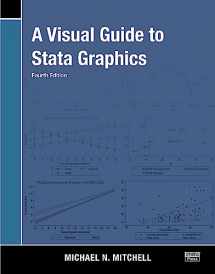
A Visual Guide to Stata Graphics
Book details
Summary
Description
Michael Mitchell's A Visual Guide to Stata Graphics, Fourth Edition provides an essential introduction and reference for Stata graphics. The fourth edition retains the features that made the first three editions so useful: A complete guide to Stata's graph command Exhaustive examples of customized graphs Visual indexing of features-just look for a picture that matches what you want to do This edition includes new discussions of color, Unicode characters, export formats, sizing of graph elements, and schemes. The section on colors has been greatly expanded to include over 50 examples that demonstrate how to modify colors, add transparency, and change intensity. In the discussion of text modifications, Mitchell now shows how to include Unicode characters such as Greek letters, symbols, and emojis. New examples have also been added that show how to change the size of graph elements such as text, markers, and line widths using both absolute units (points, inches, and centimeters) as well as relative units (line large or *2 for two times the original size). Finally, the look of graphs throughout the book has changed-most graphs are now created using a common updated scheme. The book's visual style makes it easy to find exactly what you need. A color-coded, visual table of contents runs along the edge of every page and shows readers exactly where they are in the book. You can see the color-coded chapter tabs without opening the book, providing quick visual access to each chapter. The heart of each chapter is a series of entries that are typically formatted three to a page. Each entry shows a graph command (with the emphasized portion of the command highlighted in red), the resulting graph, a description of what is being done, and the dataset used. Because every feature, option, and edit is demonstrated with a graph, you can often flip through a section of the book to find exactly the effect you are seeking. The book begins with an introduction to Stata graphs that includes an overview of graphs types, schemes, and options and the process of building a graph. Then, it turns to detailed discussions of many graph types-scatterplots, regression fit plots, line plots, contour plots, bar graphs, box plots, and many others. Mitchell shows how to create each type of graph and how to use options to control the look of the graph. Because Stata's graph command will let you customize any aspect of the graph, Mitchell spends ample time showing you the most valuable options for obtaining the look you want. If you are in a hurry to discover one special option, you can skim the chapter until you see the effect you want and then glance at the command to see what is highlighted in red. After focusing on specific types of graphs, Mitchell undertakes an in-depth presentation of the options available across almost all graph types. This includes options that add and change the look of titles, notes, and such; control the number of ticks on axes; control the content and appearance of the numbers and labels on axes; control legends; add and change the look of annotations; graph over subgroups; change the look of markers and their labels; size graphs and their elements; and more. To complete the graphical journey, Mitchell discusses and demonstrates the 12 styles that unite and control the appearance of the myriad graph objects. These styles are angles, colors, clock positions, compass directions, connecting points, line patterns, line widths, margins, marker sizes, orientations, marker symbols, and text sizes. You won't want to overlook the appendix in this book. There Mitchell first gives a quick overview of the dozens of statistical graph commands that are not strictly the subject of the book. Even so, these commands use the graph command as an engine to draw their graphs; therefore, almost all that Mitchell has discussed applies to them. He also addresses combining graphs-showing you how to create complex and multipart images from previously created gra


We would LOVE it if you could help us and other readers by reviewing the book
Book review



